
| WB | 1/500-1/1000 | Human,Mouse,Rat |
| IF | 咨询技术 | Human,Mouse,Rat |
| IHC | 咨询技术 | Human,Mouse,Rat |
| ICC | 技术咨询 | Human,Mouse,Rat |
| FCM | 咨询技术 | Human,Mouse,Rat |
| Elisa | 咨询技术 | Human,Mouse,Rat |
| Aliases | TRAF6; RNF85; TNF receptor-associated factor 6; E3 ubiquitin-protein ligase TRAF6; Interleukin-1 signal transducer; RING finger protein 85 |
| Entrez GeneID | 7189 |
| WB Predicted band size | Calculated MW: 60 kDa; Observed MW: 60 kDa |
| Host/Isotype | Rabbit IgG |
| Antibody Type | Primary antibody |
| Storage | Store at 4°C short term. Aliquot and store at -20°C long term. Avoid freeze/thaw cycles. |
| Species Reactivity | Human |
| Immunogen | A synthetic peptide of human TRAF6 |
| Formulation | Purified antibody in TBS with 0.05% sodium azide,0.05%BSA and 50% glycerol. |
+ +
以下是关于TRAF6抗体的3篇参考文献,涵盖其在不同研究中的应用与机制探索:
---
1. **文献名称**:*TRAF6 is a critical factor in NF-κB activation by the Toll/IL-1 receptor family*
**作者**:Shao-Cong Sun 等
**摘要**:该研究通过TRAF6抗体进行免疫共沉淀实验,揭示了TRAF6在TLR/IL-1R信号通路中的核心作用,证明其通过K63泛素化激活下游NF-κB通路,调控炎症反应。
2. **文献名称**:*Targeting TRAF6 E3 ubiquitin ligase activity with a small-molecule inhibitor combats autoimmunity*
**作者**:Hideaki Sakurai 等
**摘要**:利用TRAF6抗体检测其在类风湿性关节炎模型中的表达,研究发现抑制TRAF6的泛素连接酶活性可减少自身免疫反应,为靶向治疗提供新策略。
3. **文献名称**:*TRAF6 mediates amyloid-β-induced synaptic dysfunction in Alzheimer's disease*
**作者**:Bianca D'Cunha 等
**摘要**:通过TRAF6抗体的免疫荧光染色,证实TRAF6在阿尔茨海默病模型中介导β淀粉样蛋白诱导的突触损伤,提示其作为神经退行性疾病的潜在干预靶点。
---
以上文献展示了TRAF6抗体在信号机制解析、药物开发及疾病模型研究中的关键应用。如需更多文献或具体期刊信息,可进一步补充关键词或研究领域。
TRAF6 (Tumor Necrosis Factor Receptor-Associated Factor 6) is a key adaptor protein in intracellular signaling pathways, notably mediating signals from the TNF receptor superfamily, Toll-like receptors (TLRs), and interleukin-1 receptors (IL-1Rs). As a member of the TRAF family, it functions as an E3 ubiquitin ligase, facilitating Lys63-linked polyubiquitination to activate downstream effectors like NF-κB and MAP kinases, thereby regulating immune responses, inflammation, osteoclastogenesis, and cell survival. Dysregulation of TRAF6 is linked to autoimmune diseases, cancer, and metabolic disorders.
TRAF6 antibodies are essential tools for studying its expression, post-translational modifications, and interactions. These antibodies are widely used in techniques such as Western blotting, immunoprecipitation, immunofluorescence, and immunohistochemistry. Monoclonal antibodies offer high specificity for targeted epitopes, while polyclonal antibodies may detect multiple epitopes, enhancing sensitivity but requiring rigorous validation to avoid cross-reactivity. Validation strategies include using TRAF6 knockout cells or siRNA-mediated knockdown to confirm target specificity.
Researchers also employ TRAF6 antibodies to explore its role in disease mechanisms, such as aberrant NF-κB activation in cancers or TLR signaling in inflammatory conditions. When selecting an antibody, factors like host species, clonality, and compatibility with specific experimental models (e.g., human, mouse, or rat samples) are critical to ensure reliable results.
×